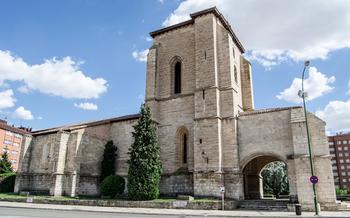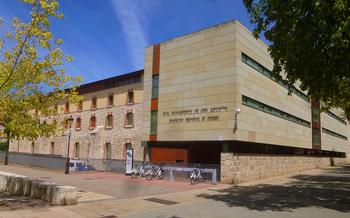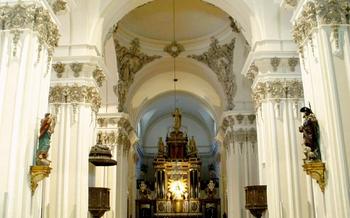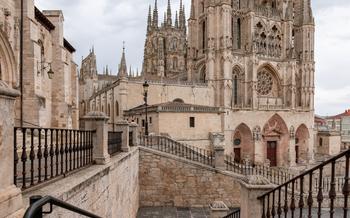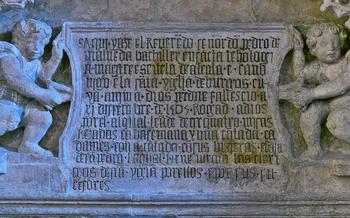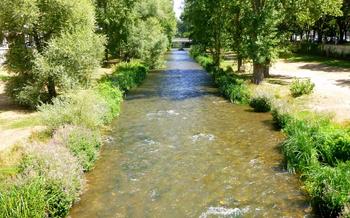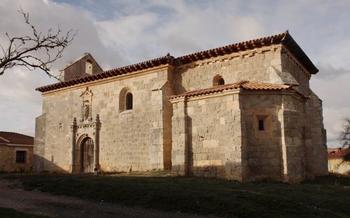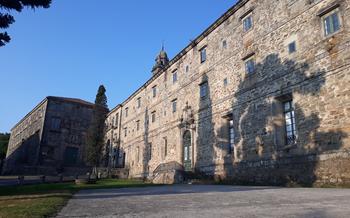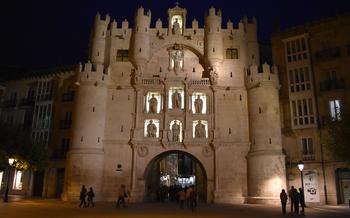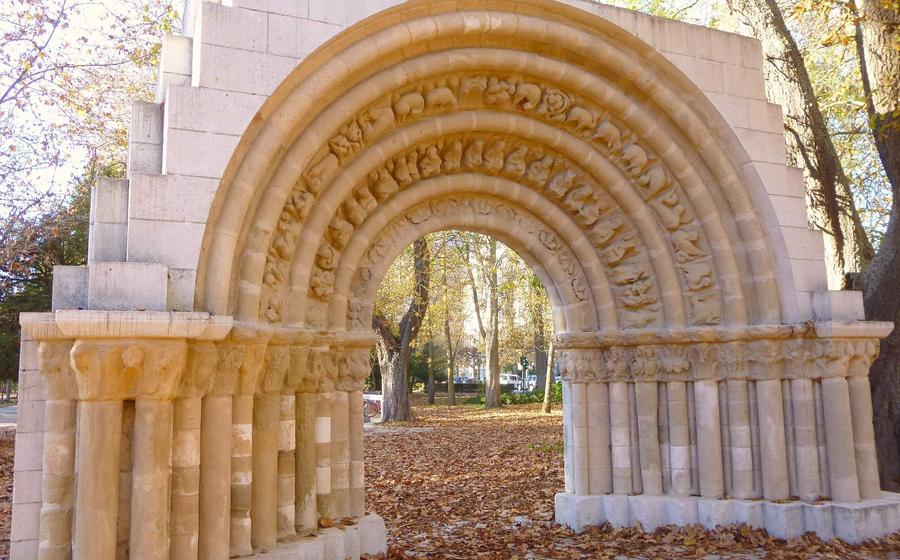
Iglesia de Nuestra Señora de la Llana
- A Monumental Treasure in Burgos: Iglesia de Nuestra Señora de la Llana
- Stepping into the Past: An Historical Overview
- An Architectural Masterpiece: Exploring the Gothic Structure
- A Realm of Art and Devotion: The Church's Interior Treasures
- The Altar of the Virgen de la Llana: A Beacon of Faith
- A Place of Worship and Reflection: The Church's Spiritual Significance
- A Sanctuary of Music and Harmony: The Church's Musical Heritage
- A Symbol of Community: The Church's Civic and Cultural Importance
- A Journey Through Time: The Church's Museum
- A Destination for Pilgrims and Tourists: Exploring the Church's Surroundings
- Practical Information for Visitors: Planning Your Visit
- Capturing the Essence: Photography and Art at the Church
- Events and Festivals: Celebrating Faith and Culture
- Stories and Legends: Uncovering the Mysteries
- Insider Tip: Unveiling a Hidden Gem
A Monumental Treasure in Burgos: Iglesia de Nuestra Señora de la Llana
In the heart of historic Burgos, Spain, stands a magnificent architectural gem that a stunning monument that holds a special place in the hearts of locals and travelers alike.
Nestled amidst the cobblestone streets of the city center, the church welcomes pilgrims and visitors with its imposing presence. Its Gothic architecture, intricate details, and profound religious significance create an aura of awe and reverence, inviting all who enter to explore its sacred spaces and discover the stories that unfold within its walls.
Stepping into the Past: An Historical Overview
The Iglesia de Nuestra Señora de la Llana has a rich history that is deeply intertwined with the development of Burgos. Its origins can be traced back to the 13th century when it was first constructed as a small chapel dedicated to the Virgin Mary. Over the centuries, the church underwent several expansions and renovations, reflecting the growing importance of Burgos as a religious and cultural center.
The church played a significant role in the development of the city, serving as a place of worship, gathering, and education. It was closely associated with the local clergy and nobility, who contributed to its growth and embellishment. Throughout its history, the church witnessed notable events and was associated with influential figures, including saints, bishops, and scholars.
In the 15th century, the church underwent a major transformation with the addition of the Gothic facade and the enlargement of the interior. This period marked the church's transition into a grand and imposing structure that would become a symbol of Burgos's architectural and religious heritage.
Preservation and restoration efforts have been ongoing to maintain the church's historical integrity and grandeur. In recent years, the church has undergone extensive renovations to address structural issues and restore its original features. These efforts have ensured that the Iglesia de Nuestra Señora de la Llana continues to stand as a testament to the city's rich past and enduring faith.
An Architectural Masterpiece: Exploring the Gothic Structure
The Iglesia de Nuestra Señora de la Llana is a testament to the grandeur and artistry of Gothic architecture. The exterior of the church commands attention with its intricate carvings, flying buttresses, and soaring spires. The facade is adorned with statues of saints and Biblical figures, creating an awe-inspiring entrance that invites visitors to step into the realm of the divine.
Upon entering the church, one is met with a sense of spaciousness and grandeur. The interior is characterized by its high vaulted ceilings, supported by slender columns that create an atmosphere of ethereal lightness. The nave is lined with chapels, each showcasing unique architectural details and exquisite stained-glass windows that bathe the space in colorful light.
One of the most striking features of the church is its intricate ribbed vaulting. The complex web of arches and ribs adds depth and dimension to the ceiling, creating a mesmerizing visual effect. The intricate carvings on the ribs and bosses depict scenes from the Bible, adding a layer of symbolism and sacred narrative to the architectural masterpiece.
A Realm of Art and Devotion: The Church's Interior Treasures
Stepping inside the Iglesia de Nuestra Señora de la Llana is like stepping into a sacred realm adorned with exquisite works of art and devotion. The church's interior is a testament to the artistic prowess and spiritual fervor that shaped its creation.
The altar, the focal point of the church, is a masterpiece of intricate carvings and vibrant colors. The altarpiece depicts scenes from the life of the Virgin Mary and is a testament to the artistry of the Gothic period. The altar is flanked by a collection of religious sculptures and paintings, each telling a story of faith and devotion.
The stained-glass windows that adorn the church's walls are a symphony of light and color. They depict biblical scenes and the lives of saints, casting a warm and ethereal glow on the interior.
The church also houses a collection of relics and devotional objects, each with its own story of faith and miracles. These relics and objects are a testament to the deep devotion that the people of Burgos have for their beloved Virgin of the Llana.
The Altar of the Virgen de la Llana: A Beacon of Faith
At the heart of the Iglesia de Nuestra Señora de la Llana lies a sacred treasure that draws pilgrims and devotees from far and wide: the Altar of the Virgen de la Llana. This exquisite masterpiece, intricately carved and adorned with gold leaf, serves as a testament to the deep devotion and artistry that permeates the church.
The origins of the Virgin of the Llana can be traced back to the 13th century, when a shepherd stumbled upon a hidden cave containing a statue of the Virgin Mary. This miraculous discovery sparked a wave of veneration throughout the region, and the statue was eventually enshrined within the church.
Over the centuries, the altar has become a focal point of pilgrimage and prayer. Devotees flock to the church to seek solace, offer prayers, and pay homage to the Virgin. The altar glistens with votive candles, each representing a personal plea or thanksgiving, casting a warm and ethereal glow upon the sacred space.
The craftsmanship of the altar is a marvel to behold. Its intricate carvings depict scenes from the life of the Virgin Mary, while the delicate tracery and gold leaf ornamentation create a sense of awe and reverence. The central niche houses the venerated statue of the Virgin, her serene expression and gentle gaze inviting contemplation and devotion.
Miracles and legends abound surrounding the Virgin of the Llana. Stories of healings, answered prayers, and divine interventions have been passed down through generations, further fueling the devotion to this sacred figure. Pilgrims often leave behind tokens of gratitude, such as rosaries, medals, or personal belongings, as a testament to the power of their faith and the blessings they have received.
A Place of Worship and Reflection: The Church's Spiritual Significance
The Iglesia de Nuestra Señora de la Llana is not just an architectural masterpiece, but also a place of deep spiritual significance for the people of Burgos. It serves as a central hub for religious practices and spiritual nourishment, fostering a profound connection between the community and their faith.
Throughout its existence, the church has been a cornerstone of the religious life in Burgos, hosting regular masses, sacraments, and religious festivals. These events bring together the community to celebrate their faith, engage in spiritual rituals, and seek solace and guidance.
Beyond scheduled services, the church is also a place of quiet contemplation and prayer. Its serene atmosphere and sacred surroundings provide a sanctuary for individuals seeking a deeper connection with their spirituality. The presence of devotional objects, such as relics and statues, further enhances the spiritual aura of the church, inviting visitors to reflect on their faith and connect with the divine.
A Sanctuary of Music and Harmony: The Church's Musical Heritage
The Iglesia de Nuestra Señora de la Llana is not only a sacred space but also a sanctuary of music and harmony. The church has a long and rich musical tradition, dating back centuries. Throughout its history, the church has been associated with renowned musicians, choirs, and sacred concerts that have filled its hallowed halls with celestial melodies.
One of the highlights of the church's musical heritage is its magnificent organ. This majestic instrument, with its towering pipes and intricate carvings, is a testament to the church's dedication to music and the arts. The organ's resonant tones reverberate through the church, creating a truly awe-inspiring atmosphere.
The acoustics of the church are exceptional, further enhancing the musical experience. The soaring vaulted ceilings and spacious interior allow sound to travel freely, creating a rich and immersive soundscape. Whether it's the ethereal voices of a choir or the virtuosic performance of an organist, the music in the Iglesia de Nuestra Señora de la Llana is truly unforgettable.
Over the years, the church has hosted numerous concerts and musical events, featuring both local and international artists. From classical to contemporary, the church's music program showcases a diverse range of genres and styles. These concerts draw music lovers from far and wide, who come to experience the unique acoustics and atmosphere of this sacred space.
The church's musical heritage is an integral part of its identity. It is a place where music and spirituality converge, creating a truly transcendent experience for visitors and pilgrims alike.
A Symbol of Community: The Church's Civic and Cultural Importance
The a vital part of the social and cultural fabric of Burgos. Throughout history, the church has played a central role in community events, celebrations, and festivals. It serves as a gathering place for locals and visitors, fostering a sense of belonging and unity. The church's spacious interior and stunning architecture provide an ideal setting for concerts, exhibitions, and other cultural events, bringing the community together to celebrate their shared heritage.
The church has also been instrumental in promoting educational and cultural initiatives. It hosts lectures, workshops, and educational programs that delve into the history, art, and spirituality of the church. These initiatives not only enrich the lives of the local community but also attract visitors from around the world, fostering cultural exchange and understanding.
The church's impact on the local community's identity is profound. Its enduring presence, architectural grandeur, and spiritual significance have shaped the cultural landscape of Burgos. It is a symbol of the city's rich history, artistic achievements, and deep-rooted faith.
A Journey Through Time: The Church's Museum
The church's museum is a captivating treasury of history, art, and religious heritage. Established to preserve and showcase the rich legacy of the Iglesia de Nuestra Señora de la Llana, the museum offers visitors a unique opportunity to delve deeper into the church's past and significance.
Within the museum's walls, a diverse collection of artifacts, documents, and religious objects awaits exploration. Ancient manuscripts, chalices, vestments, and relics provide tangible connections to the church's early days and the lives of its devoted followers. Visitors can trace the evolution of the church's architecture, art, and liturgical practices through the centuries.
Interactive exhibits and educational programs bring the church's history to life, engaging visitors of all ages. Children can embark on interactive quests, while adults can delve into scholarly research and historical texts. The museum serves as a valuable resource for researchers, historians, and anyone seeking a deeper understanding of the church's profound impact on Burgos and the wider region.
By immersing themselves in the museum's collection, visitors gain a deeper appreciation for the craftsmanship, devotion, and artistry that have shaped the Iglesia de Nuestra Señora de la Llana. It is a place where the past and present converge, inviting visitors to embark on a journey through time and discover the hidden stories that lie within the church's ancient walls.
A Destination for Pilgrims and Tourists: Exploring the Church's Surroundings
The Iglesia de Nuestra Señora de la Llana stands as a beacon of faith and architectural marvel within the historic heart of Burgos. Its location in the city center makes it a convenient starting point for exploring the city's rich cultural and historical tapestry.
Just a short walk from the church, visitors can immerse themselves in the vibrant atmosphere of Plaza Mayor, the city's main square. Here, they can admire the stunning architecture of the Gothic-style Burgos Cathedral, a UNESCO World Heritage Site, and soak in the lively ambiance of outdoor cafes and restaurants.
For those seeking a pilgrimage experience, the church is situated along the Camino de Santiago, a network of ancient pilgrimage routes leading to the tomb of Saint James the Great in Santiago de Compostela. Pilgrims from around the world pass through Burgos, making the church a welcoming haven for weary travelers.
Beyond the immediate vicinity of the church, Burgos offers a wealth of attractions to satisfy the curious traveler. History buffs can delve into the city's past at the Burgos Museum, showcasing archaeological finds and artifacts from the region. Art enthusiasts can admire the works of local and international artists at the Museo de Arte Contemporáneo de Burgos.
To fully immerse oneself in the local culture, visitors can explore the city's gastronomic delights. Burgos is renowned for its traditional dishes, such as morcilla (blood sausage) and lechazo asado (roast suckling lamb). Local markets, such as the Mercado de San Agustín, offer a vibrant array of fresh produce, artisanal cheeses, and cured meats, providing a glimpse into the region's culinary heritage.
Whether seeking spiritual fulfillment, cultural enrichment, or culinary adventures, Burgos, with the Iglesia de Nuestra Señora de la Llana at its heart, offers an unforgettable journey through history, art, and faith.
Practical Information for Visitors: Planning Your Visit
To ensure a seamless and enriching visit to the Iglesia de Nuestra Señora de la Llana, it is essential to plan your trip carefully. The church welcomes visitors from all backgrounds and faiths, offering various opportunities for exploration and contemplation.
Visiting Hours and Admission Fees:
The church is open to the public daily, with specific visiting hours depending on the time of year. During the summer months, it is generally accessible from 9:00 AM to 8:00 PM, while in the winter, the hours may be shorter. Admission to the church is free of charge, allowing everyone to experience its grandeur and spiritual ambiance.
Guided Tours:
For a more in-depth understanding of the church's history, architecture, and religious significance, guided tours are available. These tours are led by knowledgeable guides who provide insights into the church's unique features and stories. Guided tours can be arranged in advance or booked upon arrival, subject to availability.
Accessibility for Visitors with Disabilities:
The church is committed to ensuring accessibility for all visitors, regardless of their physical abilities. Wheelchair ramps and elevators are available to facilitate access to different parts of the church. Visitors with disabilities are encouraged to inform the staff upon arrival to ensure they receive any necessary assistance.
Dress Code and Appropriate Attire:
As a place of worship, the church expects visitors to dress respectfully. While there is no strict dress code, it is advisable to avoid wearing shorts, tank tops, or revealing clothing. Modest and conservative attire is recommended to maintain the solemnity and sanctity of the church's environment.
Tips for Photography and Capturing the Church's Beauty:
Photography is permitted within the church, but visitors are kindly requested to be mindful of other visitors and avoid using flash photography. Tripods and professional photography equipment may require prior permission. The church's stunning architecture and intricate details offer ample opportunities for capturing beautiful photographs.
Capturing the Essence: Photography and Art at the Church
The Iglesia de Nuestra Señora de la Llana has long been a muse to artists and photographers, captivated by its architectural grandeur and intricate details. While photography is generally permitted within the church, visitors are kindly requested to be respectful and mindful of ongoing religious services and the privacy of worshippers. Using flash photography is discouraged to preserve the integrity of the church's artwork and stained-glass windows.
To capture the church's exterior in all its glory, photographers often seek vantage points from the surrounding streets, allowing them to capture the full scale and majesty of the building. The intricate facade, with its delicate carvings and statues, is best photographed in natural light, which accentuates the play of shadows and highlights.
Venturing inside the church, photographers are greeted by a symphony of light and color. The stained-glass windows, with their vibrant hues and intricate designs, cast a warm glow on the interior, creating a mystical atmosphere. The altar, with its shimmering gold and intricate carvings, is a popular subject for photographers, as are the stunning ceiling frescoes and the intricate details of the choir stalls.
The church's beauty has also inspired local artists to create works that capture its essence. Paintings, sculptures, and drawings depicting the church and its surroundings can be found in galleries and art studios throughout Burgos. These works offer a unique perspective on the church, showcasing its architectural details, religious significance, and cultural impact.
Whether through photography or other art forms, the Iglesia de Nuestra Señora de la Llana continues to inspire and captivate creative minds, preserving its legacy as a masterpiece of Gothic architecture and a source of artistic inspiration.
Events and Festivals: Celebrating Faith and Culture
The Iglesia de Nuestra Señora de la Llana is not only a place of worship but also a hub for cultural events and celebrations. Throughout the year, the church hosts a variety of festivals, concerts, and exhibitions that showcase its rich heritage and vibrant spiritual life.
One of the most important events is the annual Feast of the Virgen de la Llana, held on September 8th. This grand festival draws thousands of pilgrims and visitors who come to pay homage to the revered Virgin. The day is filled with religious processions, masses, and traditional dances, creating a festive atmosphere in the historic center of Burgos.
Throughout the year, the church also hosts sacred concerts featuring renowned choirs and musicians. The acoustics of the church, with its high vaulted ceilings and stone walls, create an ideal setting for musical performances. Visitors can enjoy the harmonious sounds of classical, sacred, and contemporary music, enhancing their spiritual and cultural experience.
In addition, the church organizes art exhibitions and workshops that showcase the works of local and international artists. These events provide a platform for talented artists to display their creations, often inspired by the beauty and history of the church. Visitors can admire paintings, sculptures, and other artworks that reflect the spiritual and cultural essence of Burgos.
These events and festivals not only celebrate the faith and devotion of the local community but also offer visitors a glimpse into the vibrant cultural life of Burgos. By participating in these events, travelers can immerse themselves in the traditions and customs of the region, creating a memorable and enriching experience.
Stories and Legends: Uncovering the Mysteries
The Iglesia de Nuestra Señora de la Llana is steeped in folklore, legends, and stories that have been passed down through generations. One of the most enduring tales is the legend of the miraculous appearance of the Virgin Mary to a shepherd boy in the 13th century. According to the legend, the Virgin instructed the boy to build a church on the spot where she appeared, and thus the Iglesia de Nuestra Señora de la Llana was born.
Another popular legend associated with the church is the story of the "Holy Chalice." It is said that the chalice used by Jesus during the Last Supper was hidden in the church during the Moorish invasion of Spain. Over the centuries, many have searched for the Holy Chalice, but it remains hidden to this day, adding to the mystique and allure of the Iglesia de Nuestra Señora de la Llana.
The church is also associated with several historical figures and events. King Alfonso VIII of Castile is said to have prayed in the church before leading his troops to victory in the Battle of Las Navas de Tolosa in 12In the 16th century, the church was visited by Saint Ignatius of Loyola, who was deeply moved by its beauty and spirituality.
The Iglesia de Nuestra Señora de la Llana continues to be a source of inspiration and fascination for those who visit it. Its rich history, legends, and stories add to its allure, making it a place where the past and present intertwine, creating a truly magical and unforgettable experience.
Insider Tip: Unveiling a Hidden Gem
Beyond the main attractions of the Iglesia de Nuestra Señora de la Llana, there are hidden corners and lesser-known features waiting to be discovered. For an exclusive experience, time your visit to coincide with a special mass or event, such as the annual feast day of the Virgin of the Llana, which draws pilgrims and devotees from across the region. During these celebrations, the church is adorned with elaborate decorations, and the atmosphere is electric with devotion and festivity.
Venturing beyond the church itself, explore the surrounding neighborhood, which is a treasure trove of hidden gems. Take a leisurely stroll along the narrow cobbled streets, admiring the historic buildings and charming squares. Seek out the hidden courtyards and gardens, which offer a tranquil respite from the bustling city.
For those seeking a truly immersive experience, consider exploring the lesser-known churches and monuments in the vicinity. The city of Burgos is home to a wealth of architectural and cultural treasures, each with its own unique story to tell. Discover hidden gems such as the Gothic masterpiece of the Cartuja de Miraflores or the Renaissance elegance of the Iglesia de San Gil.

